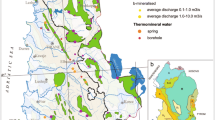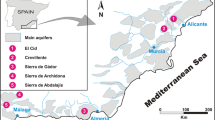Abstract
Albania is situated in the western part of the Balkan Peninsula, on the eastern coast of the Adriatic and the Ionian Sea. The karst landscape in Albania covers about 6750 km2, approximately 24 % of the Albanian territory. There are 25 karst regions in the country, 23 in carbonate rocks and 2 in evaporites. The total renewable karst water resources are estimated about 227 m3/s, representing 80 % of the groundwater resources of Albania. About 70 % of the population of the cities, including also part of the capital Tirana, obtains the water from karst springs. However, the negative human impacts often are threatening the karst groundwater resources of Albania. Several bad experiences in Albania have demonstrated that the main human negative impacts on karst water are related to: (a) urbanised areas, (b) agriculture activities, and (c) quarrying activities. Understanding the vital importance of karst waters and the necessity for intensive scientific investigations and monitoring, to evidence their high vulnerability, are still at a low level in Albania.










Similar content being viewed by others
References
Akiti T, Eftimi R, Dhame L Zojer H, Zoetl J (1989) Environmental isotope study of the interconnection between the Vjosa River and the Poçemi springs in Albania. Memoirs of 22nd Congress of IAH, vol XXII: 452–458
Aliaj Sh (2012) Neotectonic of Albania (in Albanian). KLEAN, Tirana, p 292
Aller L, Bennet T, Lehr JH, Petty RJ (1987) DRASTIC: A Standardized system for evaluating ground water pollution potential using hydrogeological settings. US. Environmental Protection Agency, Oklahoma, p 622
Amataj S, Anovski T, Benischke R, Eftimi R, Gourcy LL, Kola L, Leontiadis I, Micevski E, Stamos A, Zoto J (2007) Tracer methods used to verify the hypothesis of Cvijic about the underground connection between Prespa and Ohrid lake. Environ Geol 51(5):749–753
Amharref R, Bouchnan R, Bernoussi AS (2015) Extension of DRASTIC approach for dynamic vulnerability assessment in fissured area: application to the Angad aquifer (Marocco). In: Andreo et al. (eds), Hydrogeological and Environmental Investigations in Karst Systems, Environ. Earth Sci 1, Springer-Verlag Berlin Heidelberg, 407–414
Andreo B, Vías J, Durán Jiménez P, López-Gaeta Carrasco F (2008) Methodology for groundwater recharge assessment in carbonate aquifer:application to pilot sites in southern Spain. Hydrogeol J 16(5):911–925
Andreo B, Ravbar N, Vías JM (2009) Source vulnerability mapping in carbonate (karst) aquifers by extension of the COP method: application to pilot sites. Hydrogeol J 17:749–758
Anovski T, Andonovski B, Minceva B (1991) Study of the hydrologic relationship between Ohrid and Prespa lakes. In: Proceedings of IAEA International Symposium, IAEA-SM-Vienna, 319/62
Bakalowicz M (2005) Karst groundwater: a challenge for new resources. Hydrogeol J 13:148–160
Beqiraj A, Cenameri M, Progni F, Serjani B, Muka G, Pano N, Gjoka F, Marku S (2014) Groundwater-vulnerability mapping in Albania (Abstract) Bul. Shk. Gjeol. 2/2014—Special Issue, Proceedings of XX CBGA Congress, 103
Carré J, Oller G, Mudry J (2011) How to protect groundwater catchments used for human consumption in karst areas? 9th conference on limestone hydrogeology, 2011, Besancon, France, 87–89
Celico F, Petrella E, Naclerio G (2007) Updating of a DRASTIC-based method for specific vulnerability assessment in carbonate aquifers. Water Int 32(3):475–482
Civita M, De Maio M (1997) SINTACS: un sistema parametrico per la valutazione e la cartografia della vulnerabilità degli acquiferi al’inquinamento: metodologia e automatizzazione (a Parametric System for the Assessment and Mapping of Groundwater Vulnerability to Contamination: Methodology and Automation) Pitagora Editor, Bologna, 208
Council Directive (98/83/EC) (1998) On the quality of water intended for human consumption
Coxon C (1999) Agriculture induced impacts. In: Karst Hydrogeology and Human Activities. David Drew and Heinz Hötzl, A.A. Balkema/Rotterdam (eds) pp 37–80
Custodio E (2010) Coastal aquifers of Europe: an overview. Hydrogeol J 18:269–280
Daley D, Dassargues A, Drew D, Dunne S, Goldscheider N, Neale S, Popescu IC, Zwahlen F (2002) Main concepts of the “European approach” to karst-groundwater-vulnerability assessment and mapping. Hydrogeol J 10:340–345
De Waele J, Follesa R (2004) Human impact on karst: the example of Lusaka (Zambia). Int J Speleol 32(1/4):71–83
Denneborg M (1993) Albanienexpedition 1992 und 1993 Mitt. Verb. Dt. Höhlen-u. Karstforsch. 39(4):64–73
Dörflinger N, Zwahlen F (1998) Practical Guide, Groundwater Vulnerability Mapping in Karstic Regions (EPIK).-Swiss Agency for the Environment, Forests and Landscape. SAEFL, Bern, p 56
Drew D (1999) Introduction. In: Karst Hydrogeology and Human Activities, David Drew and Heinz Hötzl, A.A. Balkema (eds) Rotterdam, pp 3–12
Eftimi R (1991) A contribution to the hydrogeology of some karstic areas using environmental hydrogeochemical and isotope tracers (in Albanian). Ph.D. thesis Polytechnic University, Tiran, p 127
Eftimi R (2003a) Some considerations on seawater-freshwater relationship in Albanian coastal area. In: López-Geta JA (ed) Coastal aquifers intrusion technology: Mediterranean countries. Tome II, IGME, Madrid, pp 239–250
Eftimi R (2003b) Hydrogeology of Small Prespa Lake watershed. In: investigation of the upper part of Devoll River watershed. Korce, pp 1–17
Eftimi R (2005) Hydrochemical characteristics of some lithologicaly different karst massifs of Albania. In: Stevanovic Z, Milanović S (eds) Water Resources and Environment Problems in Karst—Cvijic, 2005, Beograd—Kotor, pp 499–504
Eftimi R (2010a) Hydrogeological characteristics of Albania, AQUAmundi (2010) Am01012, pp 079–092
Eftimi R (2010b) Investigation of recharge sources of Blue Eye spring, the biggest spring of Albania, by means of environmental isotope and hydrochemical tracers. In: Sustainability of the karst environment, edt. Ognjen Bonaci. IHP-VII Series on Groundwater No. 2. IHP, Division of Water Science, pp 57–65
Eftimi R, Zoto J (1996) Isotope study of the connection of Ohrid and Prespa Lakes. In: Towards integrated conservation and sustainable development of transboundary Macro and Micro Prespa lakes. Korca, pp 32–38
Eftimi R, Tafialjaj, Bisha G, Sheganaku Xh (1985) Hydrogeological map of Albania scale 1:200.000. Tirana, H. Shijaku Publ. House
Eftimi R, Amataj S, Zoto J (2007) Groundwater circulation in two transboundary carbonate aquifers of Albania; their vulnerability and protection. In: Selected Papers on Hydrogeology, vol 11. Taylor & Francis Group, London, pp 199–212
Eftimi R, Sheganaku Xh, Tafilaj I (2009) International Hydrogeological Map of Europe sc. 1:1.500.000, Sheet D6 Athinai, Albanian share, Hanover
Fetter CW (1993) Contaminant hydrogeology. Macmillan, New York, p 458
Gelaj A, Marku S, Puca N (2014) Evaluation and monitoring of groundwater of Albania Bul. Shk. Gjeol. 2/2014—Special Issue, Proceedings of XX CBGA Congress, pp 117–120
Goldscheider N (2005) Karst groundwater vulnerability mapping: application of a new method in the Swabian Al, Germany. Hydrogeol J 13:556–564
Goldscheider N (2010) Delineation of spring protection zones. In: Kresic N, Stevanovic Z (eds) Groundwater Hydrology of Springs, pp 305–338
Goldscheider N (2012) A holistic approach to groundwater protection and ecosystem services in karst terrains. AQUAmundi Am 06046:117–124
Goldscheider N, Klute M, Sturm S, Hötzl H (2000) The PI method—GIS-based approach to mapping groundwater vulnerability with special consideration of karst aquifers. Z Angew Geol 46(3):157–166 Hannover
Goldscheider N, Pronk M, Zopfi J (2010) New insights into the transport of sediments and microorganisms in karst groundwater by continuous monitoring of particle-size distribution. Geol Croat 63(2):137–142
Gunai G, Ekmekci M (1997) Importance of public awareness in groundwater pollution. In: Proceedings of the fifth international symposium and field seminars on Karst Water & Environmental, Antalya-Turkey eds Günai and Jonson, Balkema, Rotterdam, pp 3–10
Gutiérrez F, Parise M, De Waele J, Jourde H (2014) A review on natural and human-induced geohazards and impacts in karst. Earth Sci Rev 138:61–88
Hess JW, Slattery LD (1999) Extractive industries: In: David Drew and Heinz Hötzl (eds) Karst Hydrogeology and Human Activities. A.A. Balkema/Rotterdam, pp 187–200
Hötzl (H 1999) Industrial and urban produced impacts: In: David Drew and Heinz Hötzl (eds) Karst Hydrogeology and Human Activities, A.A. Balkema/Rotterdam, pp 81–123
Kanari K, Bregu V, Myftiu V, Tytymçe P, Kellolli G, Kanian B (1997) Problems of Micro Prespa Lake caused by Devoll River. In: Towards integrated conservation and sustainable development of transboundary Macro and Micro Prespa lakes, Korca, pp 181–182
Kavouri K, Plagues V, Tremoulet J, Dörfliger N, Rejiba F, Marchet P (2011) PaPRIKa: a for estimating karst resource and source vulnerability—application to the Ouysse karst system (southwest France). Hydrogeol J 19:339–353
Kessler H (1967) Water balance investigations in the karst regions of Hungary. Act Coll Dubrovnik. AIHS-UNESCO, Paris, pp 91–105
Kondo A, Meçaj B, Dalipi H, Pejo I (1971) About the presence of of a new tectonic unit (facial-structural) between Jonian Zone and Kruja Zone (in Albanian), Permb. Stud. Nr 4
Kovačič G and Ravbar N (2015) Validation of the vulnerability assessment using time series analyses-the case of the Korentan spring, SW Slovenia. In: Andreo et al. (eds), Hydrogeological and Environmental Investigations in Karst Systems, Environ. Earth Sci, vol 1. Springer, Berlin Heidelberg, pp 415–246
Kresic N, Stevanovic Z (eds) (2010) Groundwater Hydrology of Springs. Elsevier, Amsterdam, p 573
León and Parise (2009) Managing environmental problems in Cuban karstic aquifers. Environ Geol 58:275–283
Liko V (1962) Tectonics and characteristics of the development of Mali me Gropa Region (in Albanian), Bull Universiteti iTiranës, Seria Shkencat Natyrore, nr 3, pp 37–47
Loborec, J, Kapelj S, Dogančić D, Siročić AP (2015) Assessment of groundwater vulnerability in Croatian Karstic aquifers in Jadro and Žrnovnica springs catchment area. In: Andreo et al. (eds), Hydrogeological and Environmental Investigations in Karst Systems, Environ. Earth Sci vol 1. Springer, Berlin Heidelberg, pp 397–406
Matzinger A, Jordanoski M, Veljanoska-Sarafilovska E, Sturm M, Müller B, Wüest A (2006) Is Lake Prespa jeopardizing the ecosystem of ancient Lake Ohrid? Hydrobiologia 89–109 (Springer 2006)
Meço S, Aliaj Sh (2000) Geology of Albania. Gebrüder Borntraeger, Berlin-Stuttgart 246
Melo V (1965) Morpfostructure and neotectonics of Korab area (in Albanian). Stud Gjeogr Nr 6:25–35
Neukom C, Hötzl H (2007) Standardization of vulnerability maps. Environ Geol 51:689–694
Nguyet VTM, Goldscheider N (2006) A simplified methodology for mapping groundwater vulnerability and contamination risk, and its first application in a tropical karst area Vietnam. Hydrogeol J 14:1666–1675
North LA, van Beynen PE, Parise M (2009) Interregional comparison of karst disturbance: West-central Florida and southeast Italy. J Environ Manag 90:1770–1781
Parise M, Qiriazi P, Sala S (2004) Natural and anthropogenic hazards in karst areas of Albania. Nat Hazards Earth Syst Sci 4:569–581
Parise M, Qiriazi P, Sala S (2008) Evaporite karst of Albania: main features and cases of environmental degradation. Environ Geol 53:967–974
Polemio M, Pamuku A, Limoni PP, Petrucc O (2011) Caronate coastal aquifer of Vlora Bay and groundwater submarine discharge (southwestern Albania). J Coastal Res 58:26–34
Ramsar (2000) Lake Prespa. www.ramsar.org
Ravbar N, Goldscheider N (2007) Proposed methodology of vulnerability and contamination risk mapping for the protection of karst aquifers in Slovenia. Acta Carsologica 36(3):397–411
Ravbar N, Goldscheider N (2009) Comparative application of four methods of groundwater vulnerability mapping in a Slovene karst catchment. Hydrogeol J 17:725–733
Savino G, Didonna F, Parise M, Sgobba D (2003) La ricerca speleo-carsica in Albania: risultati e prospettive. Thalass Salentina 26:33–40
Stevanovic Z, Eftimi R (2010) Karstic springs of water supply for large consumers in southeastern Europe—sustainability, disputes and advantages. Geol Croat, 63/w, Zagreb pp 179–185
Tafilaj I (1979) Hydrogeology of Uji i Ftohte Springs. In: Collection of groundwater studies. Tirana, pp 1–13
Turc L (1954) The soil balance: relations between rainfall, evaporation and flow (in French). Geogr Rev 38:36–44
Van Stempoort D, Ewert I, Wassenaar L (1993) Aquifer vulnerability index (AVI): a GIS compatible method for groundwater vulnerability mapping. Can Water Res J 18:25–37
Vias JM, Andreo B, Perles MJ, Carrasco F, Vadillo I, Jiménes P (2006) Proposed method for groundwater vulnerability mapping in carbonate (karstic) aquifers: the COP method. Hydrogeol J 14:912–925
Xhomo A, Kodra A, Xhafa Z, Shallo M. (2002) Geological Map of Albania, scale 1:200,000, AGS, (in Albanian). Tirana, p 408
Zwahlen F (2004) Vulnerability and risk mapping for the protection of carbonate (karst) aquifers. European Commission, Directorate-General for research, European research area: structural aspects-COST, vol 620, p 279
Acknowledgments
We are indebted to Jo De Waele and to two other reviews for their very valuable suggestions and comments on the first version of the manuscript.
Author information
Authors and Affiliations
Corresponding author
Rights and permissions
About this article
Cite this article
Eftimi, R., Zojer, H. Human impacts on Karst aquifers of Albania. Environ Earth Sci 74, 57–70 (2015). https://doi.org/10.1007/s12665-015-4309-7
Received:
Accepted:
Published:
Issue Date:
DOI: https://doi.org/10.1007/s12665-015-4309-7




